Wet-rice farming systems have a logic of technical and economic evolution that is distinctively different from the more familiar Western pattern of agricultural development. The well-documented history of rice farming in China provides an opportunity for students to reassess some commonly held ideas about technical efficiency and sustainable growth.
From 1000 to 1800 CE China was the world’s most populous state and its most powerful and productive economy. Rice farming was the mainstay of this empire. Rice could be grown successfully in only about half of the territory, in the southern provinces where rainfall was abundant. There it was the staple food for all social classes, landlords and peasants, officials and artisans alike. The more arid climate in the north was not suited to rice; northern farmers grew dry-land grains like wheat, millet, and sorghum for local consumption. But the yields of these grains were relatively low, whereas southern rice farming produced sufficient surpluses to sustain government and commerce throughout China. Vast quantities of rice were brought north to provision the capital city— home to the political elite, the imperial court, and all the state ministries—and to feed the huge armies stationed along the northern frontier. People said that the north was like a lazy brother living off the generosity of his hard-working and productive southern sibling. Thousands of official barges carried rice from Jiangnan to the capital region along the Grand Canal, and more rice still was transported north in private ships along the coast (fig. 1). Rice also fed the growth of manufactures and commerce around the country: ever-increasing numbers of urban and rural households were able to engage in manufactures or in specialized commercial farming thanks to the steadily expanding rice trade. By 1500 China had become a “society of mass consumption,” according to some scholars, and its exports, ranging from iron cooking wares and sturdy cotton cloth to gorgeous silks and delicate porcelains, brought fully three-quarters of the world’s silver supply into China between 1500 and 1800.1
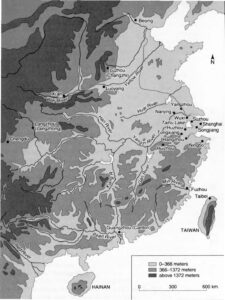
Yangzi region, south of the Huai River.
Late imperial China’s impressive and sustained economic performance was built upon the high productivity of its rice farms and the skills of its rural householders. Yet this was a socio-technical system in which farms remained tiny, equipment remained simple, and the vast majority of the population continued to live in villages. The contrast with the historical development of farming and manufacturing in the Western nations is stark, so it is not surprising that the evolution of China’s agrarian economy has been interpreted by some scholars as stagnation or worse, a system in which farmers struggled harder and harder with inadequate technology to coax a few more baskets of grain out of exhausted fields, as living standards dropped inexorably—in other words an inefficient system.2 Yet in recent years other historians have argued that this long-lasting, flexible, and productive system, which successfully nourished a population that by 1800 had grown to about 300 million, should be hailed as a “miracle” quite comparable to the “European miracle” of industrialization.3 This article outlines how the technologies associated with the intensification of rice farming helped shape this “East Asian miracle.” The illustrations are taken from some of the many splendid treatises on agriculture and rural technologies produced during this period.4
First let me sketch the contrasting model of technical development against which China’s experience is usually measured. In agriculture as in industry, mechanization and dramatic increases in the scale of operation have played a key role in the historical progress of the Western nations. If we look at developments in farming technology in countries such as Britain or the United States, say from 1600 through to 1900, we see a trend away from smallholder peasant agriculture towards bigger farms, bigger fields, and increasingly sophisticated mechanical equipment. In the United States over the last century the average size of farms has increased steadily, from a few dozen to hundreds of acres, while the number of people engaged in farming has dwindled from almost half the population to a few percent. Tractors have replaced men with horse-plows; harvesting machines sweep through the fields of wheat where once whole communities turned out to cut the grain and tie it into bundles; the exhausting task of hoeing weeds has been rendered obsolete by chemical herbicides. Wherever possible, capital equipment has been substituted for human labor.5 Small farmers cannot usually afford lots of sophisticated machinery, and large machines like combine harvesters are not suitable for a patchwork of small fields growing different crops: this is a technical system in which economies of scale make large farms and monoculture more “efficient” than small-holdings or mixed farming.
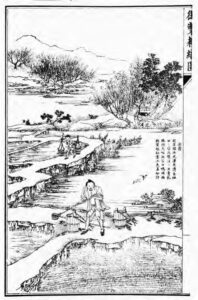
This model of large-scale industrial farming has spread inexorably across the modern world, and it is now widely accepted that an efficient farming system is one that minimizes the need for human labor, usually by substituting sophisticated and expensive equipment. By such criteria, farming in late imperial China was indeed inefficient. Yet industrial farming has its problems. Critics note its environmental unsustainability, and the social problems that arise when small farmers are driven off the land but are unable to find jobs elsewhere.6 Here I suggest that the Chinese system illustrates an alternative form of efficiency, one that is perhaps better equipped to meet some of the challenges of sustainability that we face today.
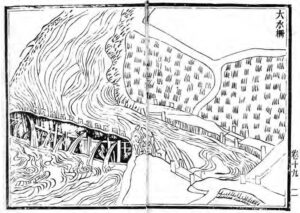
inflow into each field is through an adjustable wooden sluice. From the 1530 edition of the
Nongshu (Agricultural Treatise) by Wang Zhen, completed in 1313.
In China’s rice-growing regions, the use of land was intensified over the centuries by increasing inputs of skilled labor and maximizing the productivity of land. The characteristics of the rice plant and the technical logic of irrigation combined to shape this pattern of evolution. Rice is a monsoon crop; it can be grown in dry fields, but water is its natural habitat. The earliest finds of domesticated rice in China (some of which may date back as far as 10,000 BCE) are in naturally marshy areas close to rivers.7 However, a good rice field or paddy is one in which the water supply can be accurately regulated and drained, which means leveling the field and surrounding it by low dykes or bunds; this type of field dates back well over two thousand years in the Jiangnan and Canton regions.8 Since the depth of water throughout the field must be even, paddies were usually small by Western standards: a field twenty yards square would be considered large (fig. 2). The young seedlings need damp soil but rot in standing water; once they are about a foot tall, they like to have several inches of standing water through the period of flowering and ripening; then the field should be drained for several days before harvesting. Rainwater can easily be impounded in a bunded field, but it may all evaporate before the rice is fully-grown. Rice farmers in some hilly regions built tanks to collect rainwater, which was gradually released by gravity flow. Other common forms of irrigation included the channeling of small streams into hillside terraces, and the construction of diversion canals from larger rivers, in which case the water usually had to be pumped up into the fields (fig. 3). Poldered fields were large areas of land reclaimed from a swamp or lake by the construction of a high, solid dyke. Houses were built on the wider parts of the dyke, which was usually planted with trees to prevent erosion. Inside, the polder was divided into blocks of fields with drainage channels running down the middle (fig. 4).
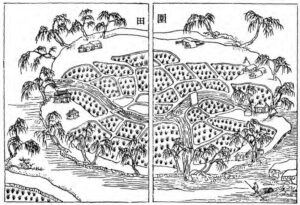
the imperially commissioned compilation of
Shoushi tongkao (Works and Days) of 1742 is
based on an original in Wang Zhen’s Nongshu
of 1313.
All these forms of water control were common in China by medieval times, and they allowed rice farming to spread from small river valleys up mountainsides and down into deltaic flood plains. Constructing bunds, irrigation networks, tanks, or terraced fields requires large initial investments of labor, but after that, maintenance is relatively cheap and easy. So it is not surprising that rice farmers have often preferred intensifying production in their existing fields to extending the cultivated area, especially since unlike dry fields, rice paddies gain rather than lose fertility over the years. Water enhances the sustainability of rice systems. “Whether the land be good or poor, if the water is clear then the rice will be good,” writes the author of Essential Techniques for the Peasantry, a Chinese agricultural treatise completed in 535 CE. High rainfall in south China leaches the soils and turns them acid, but this process is reversed by paddy-farming. Whatever the original soil fertility and structure, over several years of continuous wet-rice cultivation, the top few inches of soil turn to a fine, gray, low-acidity mud with a layer of hardpan underneath that retains the water. Nitrogen-fixing organisms that occur naturally in the paddy serve as manure, allowing farmers to harvest up to almost one ton per acre even if they add no fertilizers. But most rice farmers used some manure or compost on their fields, and by 1500 many farmers were purchasing commercially produced lime and soy-bean waste for fertilizer, or imported night-soil (human manure) from the cities, raising annual output to two or three tons per acre in some double-cropping regions. New forms of fertilizer and improved methods of application continued to raise output throughout imperial times.
The technique of transplanting rice seedlings is very productive: a small patch of fertile land is carefully tilled and manured, and sown with carefully selected pre-germinated seed. Meanwhile the main field is soaked, plowed, and harrowed to produce a fine silky mud. After a month or so the seedlings are pulled up, sickly ones are discarded, and the tops of the leaves are chopped off. Then the seedlings are replanted in shallow water in the main field. This process is very labor-intensive, but it permits careful selection of healthy plants and the efficient use of small amounts of manure; it also encourages the production of multiple seedbearing stems or tillers. By the time the seedlings are transplanted they need only a few weeks in the main field, so the land can be used for other crops in the off-season.

Over the centuries farmers developed thousands of rice varieties. Some resisted drought, others could withstand flooding or high winds, some were especially tasty, and others were good for brewing or baking. By growing several different varieties in small fields, a peasant farmer could reduce the risk of a bad harvest. Perhaps the most famous variety was the Champa rice of the far south, introduced to Jiangnan by the emperor in 1020. It required so little time in the field that a crop of winter wheat could be grown on the same land afterwards. This was just one of a series of dramatic farming improvements during the Song dynasty (960–1279) that are often referred to as a “Green Revolution.”9
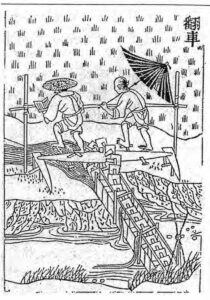
Agricultural Administration) by Xu Guangqi, published in 1639. The farmer on the left is shown reading a book as he pedals: although literacy was by then fairly common even in rural China, this is most probably a fantasy on the part of the woodblock artist.
Wet-rice cultivation thus has enormous potential for intensifying the use of land. Tanks, channels, and bunds may occupy as much as a fifth of the land, but no space need be wasted. In China, fish nibbled the weeds in the tanks or ate snails in the paddy, and ducks fed on the fish. Narrow bunds were used to grow vegetables, broad ones were planted with mulberries to feed silkworms, whose droppings were used as manure. After the rice was harvested, the fields were usually drained to grow barley, vegetables, sugar cane, or tobacco. The alternation of summer rice with winter wheat became common in Jiangnan in the eleventh century. A judicious choice of quick-maturing varieties, and abundant water, provided seventeenth-century farmers in the Canton region with two or even three crops of rice a year plus a few catch-crops of vegetables, and yearly output could total as much as three or more tons per acre.
Since paddy fields were very small, most farm implements were small and light—and cheap. A single water buffalo served the needs of a typical farm; where streams were deep, water wheels could power a chain-pump (fig. 5), but more commonly small wood-and-bamboo pumps were used that could easily be carried from field to field (fig. 6). In general rice farming did not require much capital outlay compared to Western farming systems, and there were few economies of scale to be practiced. Though a landlord might own dozens or even hundreds of acres, his home farm would be very small—one seventeenth-century agronomist advised that in his region the landowner should rent out any land over two-thirds of an acre. The rest would be let out in small parcels to large numbers of tenants, selected not for their capital assets but for their skills and experience. As one treatise written in about 1700 put it: “There are three advantages in having good tenants, namely that they are on time with plowing and sowing, they are energetic in fertilizing, and they are resourceful in conserving every drop of water. With diligence like this, one acre may yield the product of two.”10 Rice farming was a skill-oriented technological system, which depended less on equipment or heavy capital outlay than on quality of labor. A skilled small-holder or tenant was in just as good a position to raise the productivity of his land as was a wealthy landlord, thus the development of wet-rice farming did not polarize rural society and drive landless people out. The relative advantage of family smallholdings guaranteed access to land for large numbers of peasants, even if it was through tenancy. Unlike in the West, where farms and machinery steadily increased in size, in China farms and equipment became steadily smaller, as did irrigation units. The reduction in scale allowed more precise control and management, increasing the productivity of land. Better irrigation practices, improved seeds, and fertilizers all improved yields without requiring extra labor.11

The labor requirements of wet-rice farming were intermittent. Transplanting and harvesting were periods of peak demand when all family hands, and sometimes hired hands or exchange labor as well, were needed in the fields; at other times demands were low. Peasants in China were thus able to combine rice farming with the commercial production of vegetables, sugar, silk, or tea, or with the manufacture of textiles, liquor, bean curd, or handicrafts (fig. 7).12 All of these activities were organized within the household or in local workshops. Though the work was skilled, the equipment was usually fairly simple and low-cost, and so households could transfer to another form of production relatively cheaply if markets shifted, as they often did. Some regions of specialized production came to rely on the market entirely for their supply of basic foods, though most households retained some fields that could be used for rice in hard times. As an example of how complex the trading networks could be, in seventeenth-century Canton farmers turned their rice fields over to sugar, which was exchanged in the north for raw cotton, or exported to the Philippines. They made cotton and silk textiles for sale in China or for export to India and Europe through Malacca, and they imported rice from the inland provinces. The silver bullion earned from exports helped the region develop into one of China’s great cultural centers.13
Rice thus served as the foundation of a diversified rural economy that both required and absorbed the labor of a dense, and multi-skilled, population. Over the centuries this technical system not only expanded to feed a growing population,14 it underpinned flourishing manufactures and commerce. Many historians now believe that even as late as 1800, peasant living standards in China were as high as those in France, and that the environmental impact of this intensive land-use was relatively benign.15
The logic of technical and economic development in rural China was almost the exact opposite of what we see at the same period in the West, diminishing in scale, absorbing labor, and substituting human skills for sophisticated machinery. Clearly China was not following the path to industrialization of agriculture and industry—but does this mean that the system was inefficient? Surely not. In the industrializing West, engineers designed complex machines that reduced the need for farm-worker skills to a minimum.16 In rural China, human skills combined with apparently simple machines produced technologies that were highly efficient in their use of land, water, raw materials, and capital. Small farmers were not driven off the land; rural workshops were not part of an impoverished subsistence backwater, but were the powerhouses of growth, fully integrated into nation- and world-wide trading networks. As we cast around today for ways to reform the excesses of agri-business, we could do worse than to study the historical experience of China.
ARTICLES AND BOOKS CITED
An Zhimin. “Origin of Chinese rice cultivation and its spread East.” Trans. W. Tsao, ed. B. Gordon, http://www.carleton.ca/~bgordon/Rice/papers/zhimin99.htm, 1999.
Beattie, Hilary J. Land and lineage in China: a study of T’ung-ch’eng County, Anhwei, in the Ming and Ch’ing dynasties. Cambridge: Cambridge University Press, 1979.
Bray, Francesca. The Rice Economies: Technology and Development in Asian Societies. Oxford: Basil Blackwell, 1986 (repr. Berkeley: University of California Press, 1994).
—— Technology and Gender: Fabrics of Power in Late Imperial China. Berkeley: California University Press, 1997.
—— Technology and Society in Ming China (1368–1644). Washington, D.C.: Society for the History of Technology and the American Historical Association, 2000.
Brook, Timothy. The Confusions of Pleasure: Commerce and Culture in Ming China. Berkeley, University of California Press, 1998.
Daniels, Christian. Biology and Biological Technology, Agro-industries: Sugarcane Technology. Vol. VI, pt. 3, Science and Civilisation in China, ed. Joseph Needham. Cambridge: Cambridge University Press, 1996.
Elvin, Mark. The Pattern of the Chinese Past. Stanford: Stanford University Press, 1973.
Elvin, Mark and Liu Ts’ui-jung, eds. Sediments of time: environment and society in Chinese history. Cambridge: Cambridge University Press, 1998.
Frank, André Gunder. ReOrient: Global Economy in the Asian Age. Berkeley: University of California Press, 1998.
Gardella, Robert P. Harvesting Mountains: Fujian and the Chinese Tea Trade, 1757–1937, Berkeley: University of California Press, 1994.
Huang, Philip C. C. The Peasant Family and Rural Development in the Yangzi Delta, 1350–1988. Stanford: Stanford University Press, 1990.
Kloppenburg, Jack R. Jr. First the Seed: the Political Economy of Plant Biotechnology, 1492–2000. Cambridge: Cambridge University Press, 1988.
Ledderose, Lothar. Ten Thousand Things: Module and Mass Production in Chinese Art, Princeton N.J.: Princeton University Press, 2000.
Li Bozhong. Agricultural Development in Jiangnan, 1620–1850, New York: St Martin’s Press, 1998.
Marks, Robert B. Tigers, Rice, Silk, and Silt: Environment and Economy in Late Imperial South China. Cambridge: Cambridge University Press, 1998.
Mazumdar, Sucheta. Sugar and Society in China: Peasants, Technology, and the World Market. Harvard: Harvard University Asia Center, 1998.
McWilliams, Carey. Factories in the Field: the Story of Migratory Farm Labor in California. Berkeley, University of California Press, 2000 (1st ed. 1939).
Perdue, Peter. Exhausting the Earth: State and Peasant in Hunan, 1500–1850. Cambridge, Mass: Harvard University Press, 1987.
Perkins, Dwight H. Agricultural Development in China 1368–1968. Edinburgh: Edinburgh University Press, 1969.
Pomeranz, Kenneth. The Great Divergence: Europe, China. And the Making of the Modern World Economy. Princeton: Princeton University Press, 2000.
Sun, E.-T. Z. and S.-C. Sun (trans.). T’ien-kung k’ai-wu: Chinese technology in the seventeenth century. University Park: Pennsylvania State University Press, 1966.
Wirzba, Norman (ed). The Art of the Commonplace: The Agrarian Essays of Wendell Berry. Washington, D.C.: Counterpoint, 2002.
Wong, R. Bin. China Transformed: Historical Change and the Limits of European Experience. Ithaca, NY: Cornell University Press, 1997.
NOTES
1. See Brook 1998 on late imperial prosperity, Wong 1997, Frank 1998, and Pomeranz 2000 on China’s prominence in the early modern world economy. For some stunning illustrations of China’s silks and porcelains and their production, see Ledderose 2000. Some historians argue that overpopulation and internal political decay were the main reasons for China’s nineteenth-century decline; others believe that attacks by Western nations were the precipitating factors.
2. Examples include Elvin 1973, Huang 1990.
3. Pomeranz 2000: 12.
4. Bray 2000 is a short, copiously illustrated study of these works, of the printing industry that allowed their dissemination, and of several other important technical domains of late imperial China like textile production and domestic architecture.
5. The exceptions in the US today are fruit, vegetable, and tobacco farming, where delicate crops are damaged by mechanical treatment; these sectors still rely upon huge amounts of low-paid, seasonal (and usually migrant) labor.
6. For example Kloppenburg 1988, Wirzba 2002.
7. An 1999.
8. See Bray 1986 for a systematic technical survey of how rice farming was intensified in East and Southeast Asia.
9. Elvin 1973. Perdue 1987 discusses later cases of state-planned agricultural improvement.
10. Trs. Beattie 1979: 146.
11. Li 1998.
12. See Sun and Sun 1966 on household manufactures generally; Gardella 1994 on tea; Daniels 1996 and Mazumdar 1998 on sugar; Bray 1997 on textiles.
13. Marks 1998.
14. Perkins 1969. It is reckoned that the population of China doubled from 150 to 300 million between 1700 and 1850.
15. Most agree that 1800 marked a turning point both for living standards and environmental damage; see the papers in Elvin and Liu 1998.
16. Mechanization required farmers to acquire new mechanical, maintenance, and managerial skills, while either eliminating the need for hired labor or “deskilling” the tasks of most hired hands; the classic account is McWilliams 2000.

